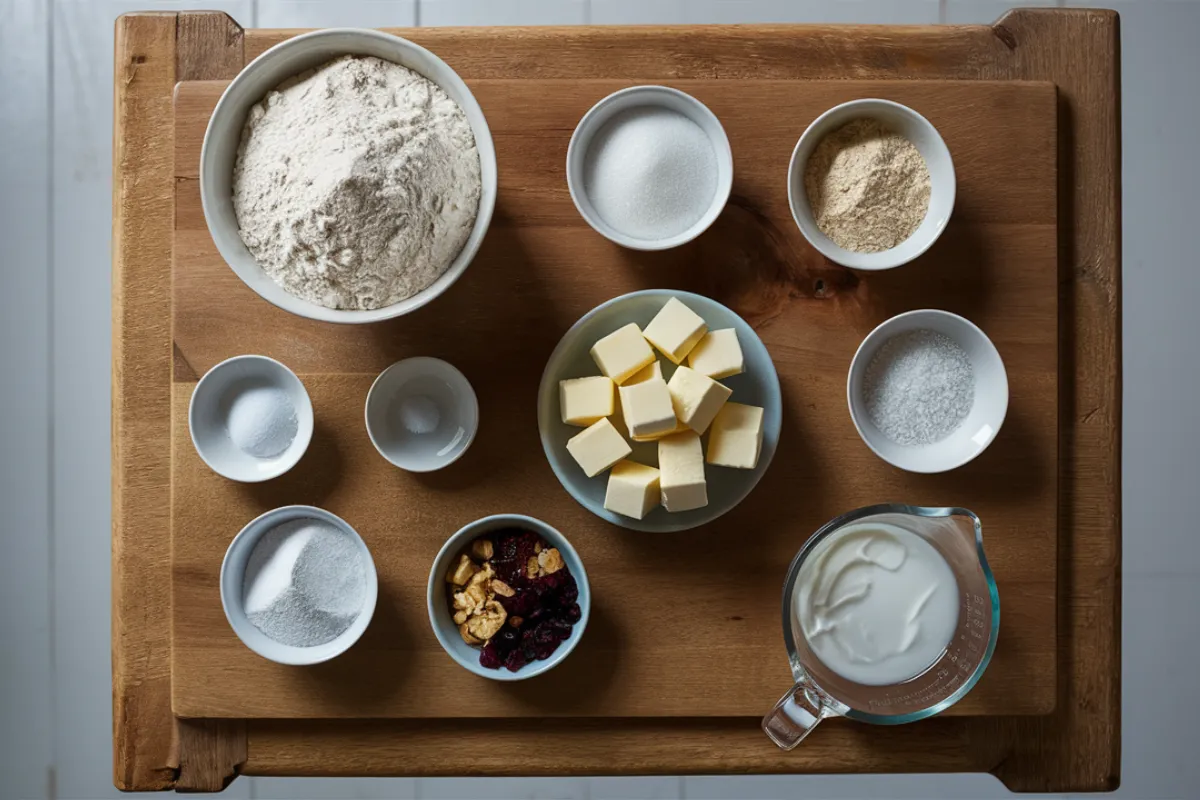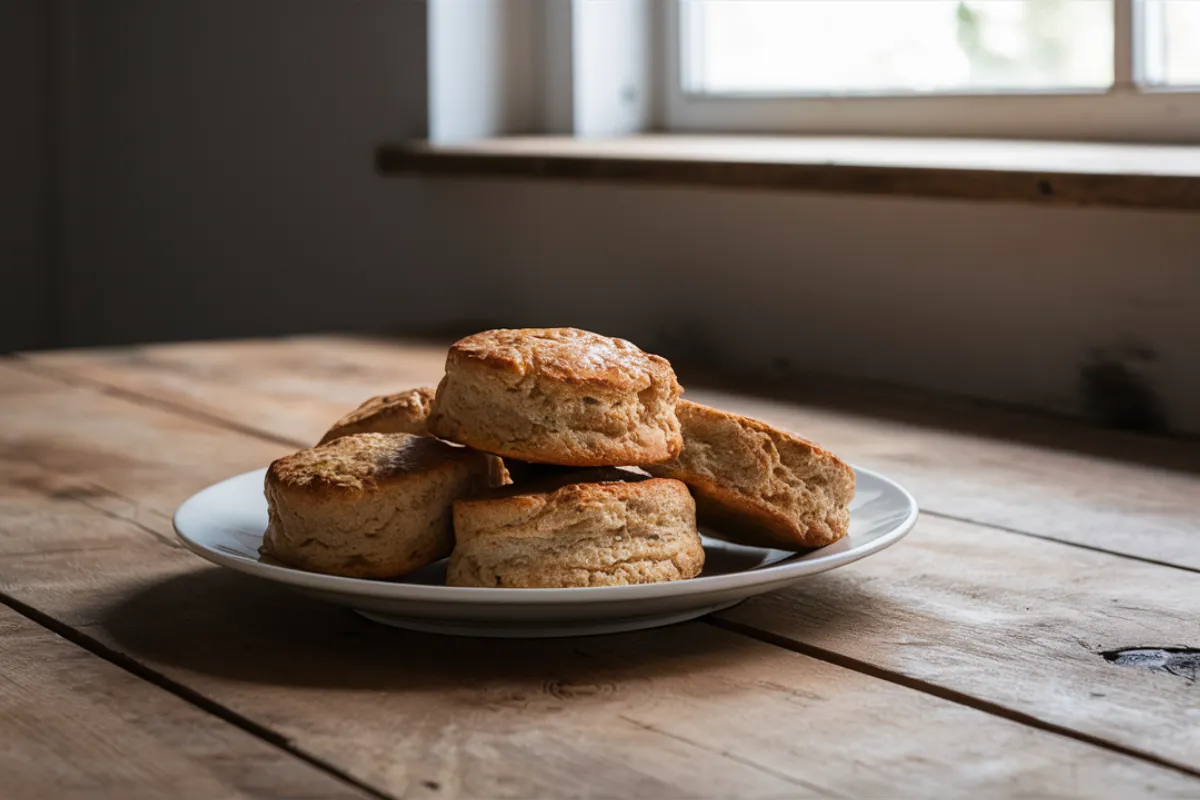Sourdough scones are a delightful twist on the traditional scone, bringing together the tangy flavor of sourdough with the buttery, flaky texture that scones are known for. If you’re looking for a way to use your sourdough starter in a new and exciting way, this sourdough scones recipe is the perfect option. Whether served for breakfast, brunch, or a cozy afternoon tea, sourdough scones can quickly become a favorite in your baking repertoire.
Ingredients for Sourdough Scones

The ingredients in sourdough scones each play a critical role in creating the perfect texture and flavor. Here is a breakdown of each ingredient and its purpose, as well as possible substitutions for those with specific preferences or dietary needs.
1. All-Purpose Flour (2 ½ cups)
- Role in Recipe: Flour forms the structure of the sourdough scones and gives them their body. The gluten in the flour helps the dough hold together while providing the desired crumbly texture. All-purpose flour is the most versatile, but you can substitute with pastry flour for a softer texture.
- Substitutions: Whole wheat flour can be used for a denser texture, but it will affect the lightness of the scones. For gluten-free options, a gluten-free all-purpose flour blend with xanthan gum works well.
2. Granulated Sugar (¼ cup)
Role in Recipe: Sugar adds a touch of sweetness to the dough, balancing out the tanginess of the sourdough starter. It also aids in the browning of the scones during baking.
Substitutions: You can substitute brown sugar for a deeper flavor or reduce the amount of sugar if you prefer a less sweet scone.
3. Baking Powder (2 tsp)
- Role in Recipe: Baking powder acts as a leavening agent, helping the scones rise and become light and fluffy. It works in conjunction with the sourdough starter to give the scones a nice lift.
- Substitutions: If you don’t have baking powder on hand, you can make your own by combining 1 part baking soda with 2 parts cream of tartar.
4. Salt (½ tsp)
- Role in Recipe: Salt enhances the flavor of the sourdough scones, balancing the sweetness and tanginess while ensuring the dough doesn’t taste flat.
- Substitutions: If using salted butter, reduce the amount of added salt slightly.
5. Cold Unsalted Butter (½ cup or 1 stick)
- Role in Recipe: Butter provides the flakiness and richness in the sourdough scones. It creates pockets of air as it melts during baking, giving the scones their tender texture.
- Substitutions: For a dairy-free option, you can use plant-based butter. Ensure it is cold, as this helps create the proper texture.
6. Sourdough Starter Discard (1 cup, unfed)
- Role in Recipe: The sourdough starter adds a subtle tangy flavor to the scones while also contributing to the overall texture. It’s a great way to use leftover sourdough discard that would otherwise go to waste.
- Substitutions: If you don’t have a sourdough starter on hand, you can replace the discard with an equal amount of buttermilk, although it won’t provide the same tangy flavor.
7. Cold Heavy Cream (½ cup)
- Role in Recipe: Heavy cream adds moisture and richness to the dough, making the scones tender and soft. The fat content in the cream helps create a delicate crumb.
- Substitutions: You can use whole milk for a lighter scone or coconut cream for a dairy-free alternative.
8. Optional Mix-Ins (½ cup total)
- Role in Recipe: Mix-ins such as dried fruits (raisins, cranberries, or currants), chocolate chips, or chopped nuts can add texture and additional flavor to your sourdough scones.
- Substitutions: Fresh fruits like blueberries or raspberries can also be used, though they may make the dough slightly wetter. Adjust the flour as needed.
Step-by-Step Guide to Making Sourdough Scones

Follow this comprehensive step-by-step guide to create the perfect batch of sourdough scones. The key to achieving the best texture and flavor lies in handling the dough carefully and keeping the ingredients cold.
Step 1: Prepare Ingredients for Sourdough Scones
- Measure and Chill: Ensure all your ingredients, especially the butter and cream, are cold. Cold butter is essential for creating flaky scones, so consider cutting it into small cubes and chilling it in the refrigerator while you measure out the other ingredients.
- Preheat the Oven: Preheat your oven to 400°F (200°C). Line a baking sheet with parchment paper or a silicone baking mat.
2: Mixing the Dry Ingredients for Fluffy Sourdough Scones
- Combine Flour, Sugar, Baking Powder, and Salt: In a large mixing bowl, whisk together the flour, sugar, baking powder, and salt. This ensures the leavening agent is evenly distributed throughout the dough.
- Cut in the Butter: Using a pastry cutter or your hands, cut the cold butter into the dry ingredients until the mixture resembles coarse crumbs with pea-sized pieces of butter. Be careful not to overmix; you want chunks of butter throughout the dough.
3: Incorporating Sourdough Starter and Cream into the Scones
- Incorporate the Sourdough Starter: Gently stir the sourdough starter into the dry ingredients until just combined. Avoid overmixing, as this can lead to tough scones.
- Add the Cream: Slowly pour in the cold heavy cream and stir until the dough starts to come together. If you’re using mix-ins, fold them into the dough at this stage.
4: Shaping the Dough for Delicious Sourdough Scones
- Turn Out the Dough: Transfer the dough to a lightly floured surface and gently pat it into a circle or rectangle about 1 inch thick. Be careful not to handle the dough too much, as this can make the scones less tender.
- Cut the Scones: Using a sharp knife or a bench scraper, cut the dough into triangles or squares, depending on your preference. You can also use a round biscuit cutter for more traditional scone shapes.
5: Bake the Scones
- Arrange on Baking Sheet: Place the cut scones on the prepared baking sheet, leaving space between each one to allow for spreading.
- Optional Topping: Brush the tops of the scones with a little heavy cream or an egg wash for a golden finish. You can also sprinkle with coarse sugar for added texture.
- Bake: Bake the sourdough scones in the preheated oven for 15-18 minutes, or until the tops are golden brown and the edges are crisp.
- Cool: Remove the scones from the oven and allow them to cool on a wire rack before serving. The scones can be enjoyed warm or at room temperature.
Tips for Perfect Sourdough Scones
Here are some helpful tips to ensure your sourdough scones turn out perfectly every time:
1. Keep Everything Cold
Keeping your ingredients, especially the butter and cream, cold is crucial for achieving flaky scones. If the butter melts before baking, you’ll end up with dense, greasy scones instead of light, flaky ones. Chill your ingredients before mixing, and if the dough becomes too warm while working with it, pop it in the fridge for a few minutes before baking.
2. Don’t Overmix
When combining the wet and dry ingredients, mix just until everything is incorporated. Overmixing can lead to tough scones due to overdeveloped gluten. Handle the dough as little as possible to keep it tender.
3. Use a Sharp Knife
If you’re cutting your scones into triangles or squares, use a sharp knife or bench scraper. This helps ensure a clean cut and promotes even rising during baking.
4. Experiment with Mix-Ins
Sourdough scones are versatile, so feel free to experiment with different mix-ins. Add dried fruits, nuts, or even savory ingredients like cheese and herbs to customize your scones to your taste.
Sourdough Scones FAQs: Common Questions Answered
1. Can I use sourdough starter discard that hasn’t been fed?
Yes! The tangy flavor in sourdough scones comes from the sourdough starter discard, and it does not need to be fed beforehand. Simply use the discard straight from the fridge if desired. Unfed starter works perfectly for this recipe, as the baking powder acts as the primary leavening agent.
2. Can I freeze sourdough scones?
Absolutely! After baking, let your sourdough scones cool completely. Then, place them in an airtight container or freezer bag and freeze for up to 3 months. When you’re ready to enjoy them, thaw at room temperature or warm them in the oven for a few minutes.
3. Why did my scones turn out flat?
Flat scones are often the result of overmixing the dough or the butter being too warm. Ensure that the butter remains cold and that you handle the dough as little as possible. Chilling the dough before baking can also help prevent flat scones.
4. Can I make sourdough scones without sugar?
Yes, the sugar in this recipe adds a subtle sweetness, but it’s not essential for the structure of the scones. You can reduce or omit the sugar for a more savory version of sourdough scones.
5. How do I store sourdough scones?
Sourdough scones can be stored at room temperature in an airtight container for up to 2 days. For longer storage, keep them in the refrigerator for up to a week, or freeze them for extended freshness.
6. Can I make the dough ahead of time?
Yes, you can prepare the dough and cut the scones in advance. Place them on a baking sheet, cover with plastic wrap, and refrigerate for up to 24 hours before baking. This is a great way to prepare ahead for a special occasion or breakfast.
7. Can I substitute the sourdough starter with something else?
While the sourdough starter adds the signature tanginess to the scones, you can substitute it with buttermilk or yogurt in a pinch. However, the unique sourdough flavor will be absent.
8. Can I add fresh fruit to the dough?
Yes, fresh fruit such as blueberries or raspberries can be added to the dough. Be mindful that fresh fruit can add moisture, so you may need to adjust the flour accordingly.
Conclusion
Sourdough scones are a comforting, versatile treat that can be enjoyed at any time of day. The tangy flavor from the sourdough starter, combined with the buttery, flaky texture of the scones, creates an irresistible snack that can be customized to suit your preferences. Whether you enjoy them with a cup of tea, as part of breakfast, or simply on their own, sourdough scones are sure to impress.
The process of making sourdough scones is simple and rewarding, with plenty of opportunities to experiment with different flavors and mix-ins. From savory to sweet, these scones are a wonderful addition to any baker’s repertoire, offering both comfort and creativity in every bite.

